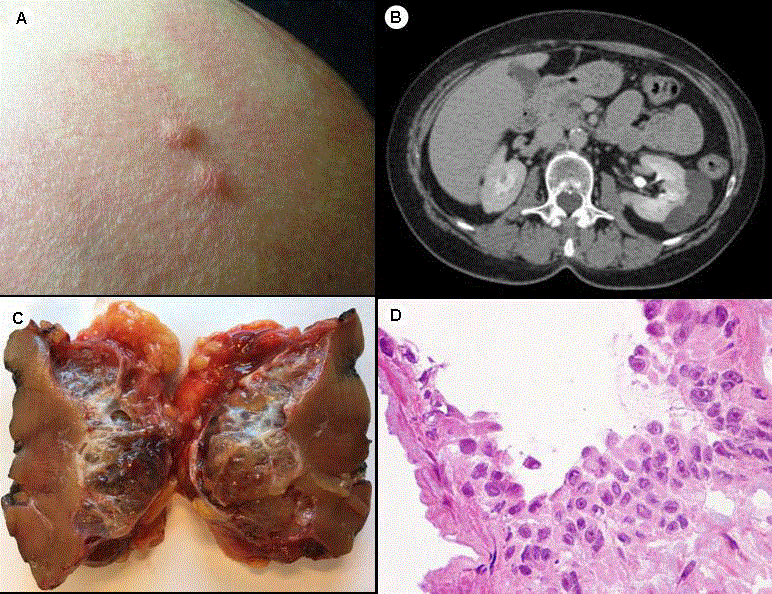Clinical Image
Renal Cell Carcinoma in Hereditary Leyomiomatosis Syndrome: When the Web Makes the Difference
Piergiuseppe Colombo1*, Maria Grazia Elefante1, Lorenzo Renne2
1Department of Pathology, Humanitas Clinical and Research Center, Humanitas University, Rozzano Milan, Italy
2Department of Pathology, Istituto Nazionale Tumori, Milan, Italy
*Corresponding author: Colombo Piergiuseppe, Department of Pathology, Humanitas Clinical and Research Center, Humanitas University, Rozzano Milan, Italy
Published: 16 Nov, 2017
Cite this article as: Colombo P, Elefante MG, Renne L.
Renal Cell Carcinoma in Hereditary
Leyomiomatosis Syndrome: When the
Web Makes the Difference. Ann Clin
Case Rep. 2017; 2: 1466.
Clinical Image
A 68-year-old woman with a history of hysterectomy for leyomioma at the age of 24 and cutaneus
leyomiomas in the past few years discovered a renal multicystic mass without clear radiological
signs of malignancy (Figure 1A and B). The patient, searching the web for possible links between
the uterine leyomioma and cutaneus leyomiomas, read about a potential syndrome and looked
for genetic consultation. Family history showed cutaneous and uterine leyomioma cases in her
maternal lineage; an Hereditary Leiomyomatosis and Renal Cell Carcinoma (HLRCC) Syndrome
was genetically confirmed through the Fumarate Hydratase mutational analysis on chromosome 1
[1].
Due to the genetic results, the CT scan was reviewed and, although the cystic mass did not
show sign of malignancy, partial nephrectomy with intraoperative consultation (“frozen section”)
was performed to confirm the nature of the lesion. The specimen was characterized by a 4.2 cm
cystic tumour with mucoid appearance (Figure C). Histological examination showed a multicystic proliferation lined by oncocytic cells, with large nuclei, prominent orangiophilic nucleoli and clear
perinucleolar halos (reminiscent of cytological modifications due to cytomegalovirus infection)
(Figure D). Based on these cytological characteristics, hallmark of the HLRCC syndrome, diagnosis of syndrome-related renal cell carcinoma was made [5]. Due to the biologically aggressiveness of this subtype of tumor, total nephrectomy was performed. At 12 months the patient is alive and
without evidences of disease.
Despite the progresses in patient care, a careful overview of clinical history is often lacking,
especially when dealing with benign disease in outpatient or in day-hospital settings; a virtuous use of
the internet by the patient allowed an early diagnosis of an aggressive neoplasm. Moreover the clinical
hypothesis, based on history, physical examination and genetics, even with a benign radiological
and macroscopic appearance, was only confirmed intraoperatively and a more aggressive surgery
was undertaken. Hereditary Leiomyomatosis and Renal Cell Carcinoma (HLRCC) Syndrome is rare but can be encountered in daily practice; an early diagnosis can be made only if this condition is suspected [1-5].
Figure 1
Figure 1
(A) Multiple cutaneous leyomiomas. (B) Inconclusive renal cystic mass of the left kidney. (C) Gross
section of the tumour. (D) Frozen section showing thin walled cyst lined by oncocytic (pink) cells, with large
nuclei, prominent orangiophilic (cherry) nucleoli and clear perinucleolar halos.
References
- Merino MJ, Torres-Cabala C, Pinto P, Linehan WM. The Morphologic Spectrum of Kidney Tumors in Hereditary Leiomyomatosis and Renal Cell Carcinoma (HLRCC) Syndrome. Am J Surg Pathol. 2007; 31(10):1578-1585.
- Kiuru M, Launonen V, Hietala M, Aittomäki K, Vierimaa O, Salovaara R, et al. Familial cutaneous leiomyomatosis is a two-hit condition associated with renal cell cancer of characteristic histopathology. Am J Pathol. 2001; 159(3):825-829.
- Launonen V, Vierimaa O, Kiuru M, Isola J, Roth S, Pukkala E, et al. Inherited susceptibility to uterine leiomyomas and renal cell cancer. Proc Natl Acad Sci U S A. 2001; 98(6):3387-3392.
- Tomlinson IP, Alam NA, Rowan AJ, Barclay E, Jaeger EE, Kelsell D, et al. Germline mutations in FH predispose to dominantly inherited uterine fibroids, skin leiomyomata and papillary renal cell cancer. Nat Genet. 2002; 30(4):406-410.
- Toro JR, Nickerson ML, Wei MH, Warren MB, Glenn GM, Turner ML, et al. Mutations in the fumarate hydratase gene cause hereditary leiomyomatosis and renal cell cancer in families in North America. Am J Hum Genet. 2003; 73(1):95-106.

